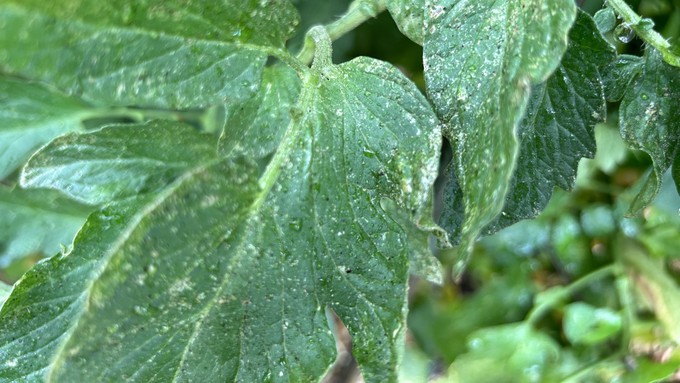
Stay hydrated and give your plants a morning shower

Spider mites cause damage by sucking cell contents from leaves, leaving stippling like this. As infestations increase, thin webbing will be visible on leaves and stalks. Kathy Morrison
How is heat affecting your garden? After a record-high 109 in Sacramento on Sunday, some plants may seem kind of crispy. (Or covered in spider mites.)
Sacramento may see a little Delta breeze relief on Tuesday and Wednesday. According to the National Weather Service, temperatures will top out in the low 90s midweek. That cool-off will come in part because overnight lows will return to normal; instead of sticking in the 70s, night-time temperatures will dip back down into the refreshing 50s. That will get mornings off to a cooler start, too.
But more triple-digit days are coming soon. The weather service predicts Sacramento will see 106 on Friday and 102 on Saturday.
“Keep your water bottle close by,” tweeted the NWS Sacramento office Monday morning.
Staying hydrated is important for people, pets and plants. Wildlife could use some water, too; a shallow saucer of water can become a bee oasis. Refill the bird bath.
Limit outdoor activity to before 10 a.m., if possible. Remember: Drink before you’re thirsty.
As for your garden, irrigate in the early morning (preferably) or late evening to cut down on evaporation.
Large-leaf plants such as hydrangeas or squash tend to wilt in the afternoon; that’s normal. If they’re still droopy in the morning, they likely need water.
Check soil moisture before irrigating; plant stress signs indicating too much water (yellow leaves, droopiness, dropped foliage, etc.) look similar to not enough. Container plants, which may need daily watering in this heat, can become over-watered if drainage holes are blocked; their roots drown in all the extra water.
This heat wave has brought dry, dusty conditions – perfect for an explosion of spider mites. And that’s just what we’ve seen, particularly on tomatoes and roses.
The best and fastest remedy for spider mites: Water. Give your plants a shower. With the hose, spray plants, washing off the mites’ webs. Try to wet the bottom side of foliage, too. No miticide is necessary, and the plant will appreciate the extra irrigation.
Spraying dust off leaves can help prevent a mite attack before you see those telltale webs. It also helps the leaves “breathe” and cope with hot weather. It’s better to shower plants in the morning so foliage has a chance to dry completely (and avoid fungal outbreaks), but that’s not a problem this week; common fungal diseases (such as powdery mildew) are inactive in this heat.
For more advice on spider mites: https://ipm.ucanr.edu/PMG/PESTNOTES/pn7405.html.
Comments
0 comments have been posted.Sacramento Digs Gardening to your inbox.
Sites We Like
Garden Checklist for week of May 5
Survey your garden after the May 4 rainstorm. Heavy rain and gusty winds can break the neck of large flowers such as roses. Also:
* Keep an eye on new transplants or seedlings; they could take a pounding from the rain.
* Watch out for powdery mildew. Warmth following moist conditions can cause this fungal disease to “bloom,” too. If you see a leaf that looks like it’s dusted with powdered sugar, snip it off.
* After the storm, start setting out tomato transplants, but wait on the peppers and eggplants (they want warmer nights). Pinch off any flowers on new transplants to make them concentrate on establishing roots instead of setting premature fruit.
* Trim dead flowers but not leaves from spring-flowering bulbs such as daffodils and tulips. Those leaves gather energy to create next year's flowers. Also, give the bulbs a fertilizer boost after bloom.
* Pinch chrysanthemums back to 12 inches for fall flowers. Cut old stems to the ground.
* Mulch around plants to conserve moisture and control weeds.
* From seed, plant beans, beets, cantaloupes, carrots, corn, cucumbers, melons, pumpkins, radishes and squash.
* Plant onion sets.
* In the flower garden, plant seeds for asters, cosmos, celosia, marigolds, salvia, sunflowers and zinnias. Transplant petunias, zinnias, geraniums and other summer bloomers.
* Plant perennials and dahlia tubers for summer bloom.
* Don’t wait; plant summer bulbs, such as gladiolus and tuberous begonias.
* Harvest cabbage, lettuce, peas and green onions.